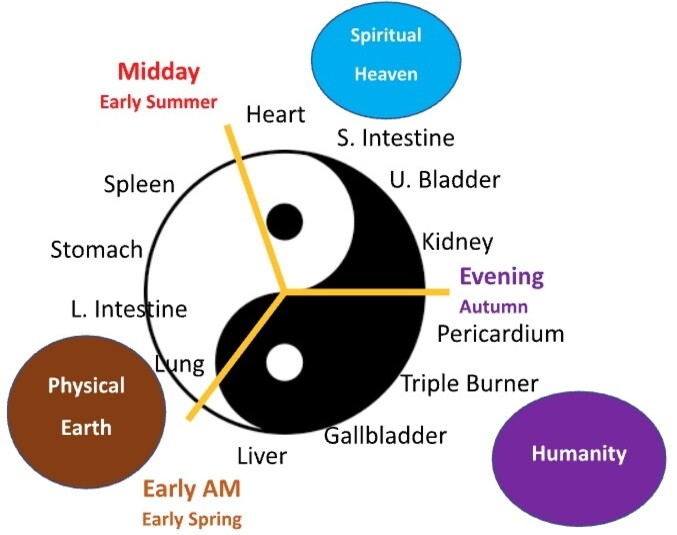Twelve Functions of Nature

Chinese medicine is a science. It's the study of the world's macrocosm in its universe and the parallels of the microcosm of the human/animal body relating to this larger world.
In its most fundamental nascence, the universe is composed of matter (Yin) and energy (Yang) which come together to form Qi. The 'ten thousand things' of our universe (once thought to be quite a large number!) are the manifestations of this energy and matter coming together, the manifestations of Qi.
Any science will have nomenclature, divisions, and systems, and the study of medicine is no different. The twelve functions of nature refer to the twelve channels of the body, each pertaining to an internal medical organ. These organs function at all times of day and night, all months of the year, but these actions are maximally expressed at specific times of day and times of the year.

This diagram begins to explain how the ancient Chinese conceived of the circadian and annual rhythm. Twelve organs are arrayed over the day and year, each of which is maximally expressed in a two-hour period of time or a month of the year.
The Lung (capitalized here to differentiate it from the biomedical lung, which is responsible for ventilation and oxygenation) begins the circadian rhythm between 3:00 and 5:00 AM. This is a good time for early waking, meditative breathing, and setting the intention for the day.
The ancients knew these organs had to encompass not just the physical action of an organ (e.g., the lungs ability to ventilate) but, additionally, the mental-emotional and spiritual aspects of the organ.
In the example of the Lung function, the even and equitable distribution of resources to the body via ventilation and oxygenation dovetails nicely with the concept of meting out justice and resources evenly to a population of people. Thus people with strong Lung function have a good sense of fairness and honesty in their actions. On a spiritual level, the act of calm, steady breathing restores peace to one's spirit.
Deep breathing improves oxygenation to the brain, and releases calming neurotransmitters to the circulation. An inability to breathe causes panic rapidly. Therefore, the Lung functions in multiple ways. It has the properties of evenness, equity (equal inhalation and exhalation), justice, and peace. In a Western medical paradigm, several of these qualities would be ascribed to the mind or even the soul. But the ancients understood that their physical functions and their mental-emotional-spiritual beings were inextricably linked. Therefore, the twelve organ clock (figure 1, above) is composed of twelve physical organs (including the less clearly defined Triple Heater), which together approximate the functions of the human nervous system and all of its higher consciousness.
Another interesting aspect of the circadian and annual rhythm visible in the figure above are three divisions of the day/year. (Remember this metaphor of the macrocosm – microcosm was developed in middle China, where the seasons were distinct, much like the middle of the United States).
In the first third of the year, the Lung, Large Intestine, Stomach, and Spleen process inhaled air and ingested food to make energy (Qi), Blood, and Body fluids for the growth and sustainability of the organism. This third is seen in the development of a person from birth to early adulthood, forming the ego, building the physical, and accumulating abilities. This is associated with earthly functions; physical, perhaps at times more crude, building a vessel to house the spirit.
The second third of the year is less material and more spiritual. It represents a time in life reserved for reflection, storage of resources, and wisdom. The Heart, Small Intestine, Urinary Bladder, and Kidney are maximally expressed during this more Heavenly (ethereal) portion of the day.
In the final third of the day/year, there's a reintegration of the energies and materials gained through the first two-thirds of the year. Restoring energy by sleeping, moving internally with one's thoughts, and even accepting one's mortality are all functions of this last third portion of the day and year.
On the Qi Vet Clinic website, we'll discuss the twelve organs and how in health, these organs function optimally. Still, in disease states, various imbalances begin to manifest.
A Holistic Approach to Pet Healthcare
Become a New Client.